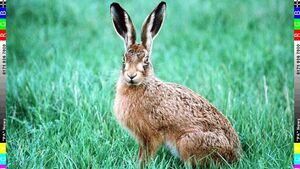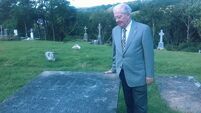Hares have a special place in Irish mythology

Brown hares are invasive to Ireland and were first seen here in 1852.
The life of the hare is quite a secretive affair; often the information we hear about hares, and the lives they live, is a strange mixture of fact and fiction. Noted in folklore for its swiftness, alertness and agility, the hare was also regarded as a fairy animal associated with deception and witchcraft.
There is a special thrill in seeing a hare; the hare has a bit of mystery, a bit of the supernatural about him. His world is only seen in glimpses or in heroic literary tales of fantastical achievements but thankfully, the hare is still to be seen in some fields around the Ox Mountains.
For centuries, we have respected, even feared, the hare because of its perceived powers of solitude and remoteness. Like the moon, which always changes places in the sky, hares were full of mystery and contradictions. The Celts believed that the goddess Eostre's favourite animal and accompanying spirit was the hare. It represented love, fertility and growth and was associated with the moon. A piece written for in 2015, provides information on the hare as it is seen in various mythologies around the world.
There are a few different species of hare. Here in Ireland, there is the brown hare and the Irish hare. While they are similar, they are not the same. Vincent Wildlife Trust Ireland provides the following information on the Irish hare.
Brown hares are easily distinguished from Irish hares based on the length of their ears in proportion to the head - brown hare’s ears are longer than the head. Brown hares are invasive to Ireland and were first seen here in 1852.
Rathlin Stickybeak is a blog written by two self-professed nature nerds from the island, which is situated off the north Antrim coast. It seems that on Rathlin, they have a very special hare indeed.
.
Most young are born between March and September. Spring is the main mating season and this is when 'mad March hares' may be seen. After a gestation period of 42 to 44 days, two or three leverets (young hares) are born in a grass-lined nest within a form. Baby hares are born fully furred and with their eyes open.
After birth, the mother puts each leveret in its own form, usually in long grass, and visits them once every night, to suckle them. While she is away, the leverets lie low and still, to avoid detection by predators. When the mother is approaching, she gives them a low call and their answering calls help her to find them.
It may shock readers of a certain age to know that hares were once hunted for meat and chased for sport. Fifty years ago, and more, my father used to shoot hares. This was not done to persecute the local hare population; they were shot for their meat. I still remember the wild game taste of hare from my childhood. The hare, of course, was - and still is - a central piece of Ireland’s coursing industry. Thankfully, it is a ‘sport’ that is growing less and less.
John B Keane refers to the hare in his play, . The tinker men describe a scene where they observe the underhand activities of others as they sit at their campfire boiling a hare. The hare was a valuable food source for such disenfranchised and marginalised people. Now, we live in more enlightened time and the hope that the hare can run free and prosper. I do however love the old adage:
Next spring, as dawn comes earlier, take a morning walk in the hope of seeing a hare. If you are lucky, you might even see two, possibly a whole bunch. They might be just lazily enjoying a few blades of new grass in a mountain meadow or they could even be ‘boxing’ each other, males and females alike. At full moon some night, take a close look to see if you can make out, not the man-o-the-moon but, the hare-o-the-moon.
To conclude, and on a practical note, hares are easily blinded by car headlights. If you catch a hare in your lights, slow to a stop and turn off your lights. In this way you will allow the hare to escape - you’ll be glad that you did and so will the hare.






